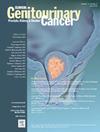Diagnosis, Treatment and Survival From Penile Cancer: Real-World Data From the National Health Service England Between 2013 and 2020
IF 2.7
3区 医学
Q3 ONCOLOGY
引用次数: 0
Abstract
Introduction
The NHS National Disease Registration Service (NDRS) collects and curate data on cancer diagnoses. We report data for patients diagnosed with penile cancer (PeCa) in England between 2013 and 2020.
Patient and Methods
Data were extracted from the NDRS “Get Data Out” database. The incidence per year, route to diagnosis (RTD), treatment modalities and overall survival were analyzed.
Results
4,268 men were diagnosed with PeCa between 2013 and 2020. The number of diagnoses increased from 485 in 2013 to 635 in 2019 (30.9% increase). 2168 (50.8%) patients had stage I-II disease and 824 (19.3%) had stage III-IV disease. The stage was unknown in 1,276 (29.9%) cases. The majority were diagnosed through the 2-week-wait (2ww) referral pathway (n = 1072, 34.2%) or via GP referrals (n = 1083, 34.6%). 263 (8.4%) patients presented as emergencies, with this RTD being more common in men aged ≥70 years (P = .04) or men with stage III-IV (P = .01). The most common treatment modality was surgery alone (n = 3,391, 79.5%). 56 (1.3%) men had radiotherapy and/or chemotherapy alone, which was more common in stage III-IV disease. At 12, 24 and 60 months, overall survival across all years was 86.3%, 77.6% and 63.8% respectively. Survival remained relatively stable over time. Patients aged ≥70 years (P < .0001) or with stage III-IV (P < .0001) had poorer survival.
Conclusion
The NDRS provides valuable data on the rising incidence of PeCa, RTD, treatment and survival in England. Most of the patients were diagnosed through the 2ww or GP referral routes. Surgery was the primary treatment modality and survival remained stable over time.
阴茎癌的诊断、治疗和生存:2013年至2020年英国国民健康服务的真实世界数据。
简介:NHS国家疾病登记服务(NDRS)收集和整理癌症诊断数据。我们报告了2013年至2020年间英格兰诊断为阴茎癌(PeCa)患者的数据。患者和方法:数据从NDRS“Get Data Out”数据库中提取。分析年发病率、诊断途径(RTD)、治疗方式和总生存期。结果:2013年至2020年间,4268名男性被诊断为PeCa。诊断数量从2013年的485例增加到2019年的635例(增长30.9%)。2168例(50.8%)为I-II期疾病,824例(19.3%)为III-IV期疾病。1276例(29.9%)患者分期不详。大多数通过2周等待(2ww)转诊途径(n = 1072, 34.2%)或通过GP转诊(n = 1083, 34.6%)诊断。263例(8.4%)患者出现紧急情况,这种RTD在年龄≥70岁的男性(P = 0.04)或III-IV期男性(P = 0.01)中更为常见。最常见的治疗方式是单纯手术(n = 3391, 79.5%)。56名(1.3%)男性单独接受放疗和/或化疗,这在III-IV期疾病中更为常见。在12、24和60个月时,所有年的总生存率分别为86.3%、77.6%和63.8%。随着时间的推移,存活率保持相对稳定。年龄≥70岁(P < 0.0001)或III-IV期(P < 0.0001)的患者生存率较差。结论:NDRS为英国PeCa、RTD、治疗和生存率的上升提供了有价值的数据。大多数患者通过2ww或GP转诊途径诊断。手术是主要的治疗方式,生存率一直保持稳定。
本文章由计算机程序翻译,如有差异,请以英文原文为准。
求助全文
约1分钟内获得全文
求助全文
来源期刊

Clinical genitourinary cancer
医学-泌尿学与肾脏学
CiteScore
5.20
自引率
6.20%
发文量
201
审稿时长
54 days
期刊介绍:
Clinical Genitourinary Cancer is a peer-reviewed journal that publishes original articles describing various aspects of clinical and translational research in genitourinary cancers. Clinical Genitourinary Cancer is devoted to articles on detection, diagnosis, prevention, and treatment of genitourinary cancers. The main emphasis is on recent scientific developments in all areas related to genitourinary malignancies. Specific areas of interest include clinical research and mechanistic approaches; drug sensitivity and resistance; gene and antisense therapy; pathology, markers, and prognostic indicators; chemoprevention strategies; multimodality therapy; and integration of various approaches.
 求助内容:
求助内容: 应助结果提醒方式:
应助结果提醒方式:


